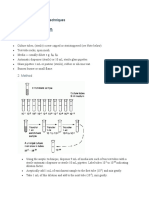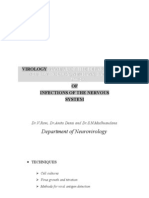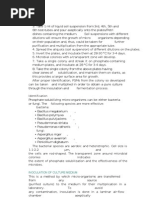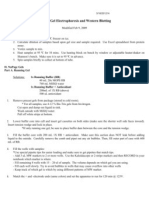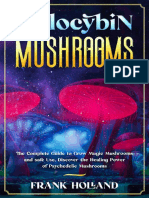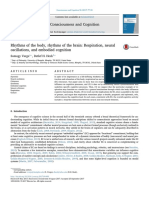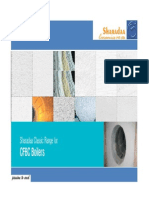Exercise 9
Uploaded by
Nueva Ilona CagampangExercise 9
Uploaded by
Nueva Ilona CagampangPre Lab Procedures:
Re– inoculate bacterial cultures into nutrient agar slants and incubate for 18-24 hours.
Prepare Mueller Hinton Agar (MHA) plate, following manufacturer's instructions and 4 test tubes
with 5mL dH2O per group and sterilize.
Grind prepared plant extracts using mortar and pestle. If plant material is less succulent, add a small
amount of water.
Filter the extract with filter paper. Final volume must be at least 5 ml
Store extract in an amber vial or test tube wrapped in aluminum foil. Do not sterilize the extracts.
Prepare 6mm Whatman filter paper disks by using a paper puncher and place in clean dry beaker
and sterilize.
Prepare 0.5 McFarland turbidity standards by mixing 0.5 aliquot of 0.048 mol/L BaCI 2 and 99.5 mL
of 0.18 mol/L H2SO4. Mix constantly.
Store in a screw-cap tube.
Sterilize 10 pcs cotton swabs in autoclavable cellophane.
Prepare alcohol lamps and forceps.
Procedures:
I. Inoculum Preparation
Pick 3-5 well isolated pure colonies from the agar slant culture.
Use an inoculating loop and transfer to 5-mL sterile distilled water.
Compare turbidity to that of the 0.5 McFarland turbidity standards by using a card with a white
background and contrasting black lines.
Add more colonies if inoculum is less cloudy. Add sterile water if it’s too cloudy.
Result should contain approximately 1-2 x 108 CFU/mL of E. coli.
II. Inoculation of Test Plates
Dip a sterile cotton swab within 5 minutes of adjusting the turbidity of the inoculum suspension into
the adjusted suspension.
Swirl swab repeatedly and press firmly on the inside of the wall of the tube above fluid level to re-
move excess.
Swab the cotton into the dried surface of the Mueller-Hinton agar plate.
Perform swabbing procedures 3 times, rotating the plate 60° after each swab to ensure even distri-
bution.
III. Application of Disks to inoculated Agar Plates
Use sterile 6 mm in diameter filter paper disks.
Use a pipette to extract 20mL of plant extract treatment and dispense into the disk. (III-2)
Position the disks from the inoculated MHA plate in a sterile place.
Place the positive control disk (antibiotic disk) on the center of the agar plate.
Use antibiotic capsule amoxicillin diluted in dH2O (500 mg/20 mL dH2O) if antibiotic disks are not
available. Repeat procedure III– 2.
Press the disks down to ensure full contact to the agar plate and ensure even distribution to avoid
overlapping zones of inhibitions.
Distance of each disk should be 24 mm from each other.
Incubate plates at 35 ± 2°C for 18 hours.
You might also like
- Introduction To Genetic Analysis (12th Edition)95% (21)Introduction To Genetic Analysis (12th Edition)819 pages
- Student Exploration: Natural Selection Gizmo56% (27)Student Exploration: Natural Selection Gizmo4 pages
- Genetic Engineering Gizmo Student Exploration Sheet50% (10)Genetic Engineering Gizmo Student Exploration Sheet7 pages
- Encyclopedia of Herbal Medicine - 3rd Edition (DK Publishing) (2016)99% (162)Encyclopedia of Herbal Medicine - 3rd Edition (DK Publishing) (2016)338 pages
- Kami Export - Gene Expression-Translation-S.161755307489% (9)Kami Export - Gene Expression-Translation-S.16175530746 pages
- Analysing Political Speeches Rhetoric, Discourse and Metaphor (Jonathan Charteris-Black) (Z-Library)No ratings yetAnalysing Political Speeches Rhetoric, Discourse and Metaphor (Jonathan Charteris-Black) (Z-Library)314 pages
- Anatomy & Physiology Made Incredibly Visual!100% (1)Anatomy & Physiology Made Incredibly Visual!412 pages
- The Immortal Life of Henrietta Lacks by Rebecca Skloot - Excerpt93% (303)The Immortal Life of Henrietta Lacks by Rebecca Skloot - Excerpt31 pages
- Disinfectant Validation Procedure: MicrobiologyNo ratings yetDisinfectant Validation Procedure: Microbiology12 pages
- Disinfectant Validation Procedure: Microbiology100% (1)Disinfectant Validation Procedure: Microbiology12 pages
- VAN MHUTE - Serial Dilution and PlatingNo ratings yetVAN MHUTE - Serial Dilution and Plating14 pages
- Datasheet: Phosphorylation. Optimal Cell Numbers Should Be Determined by Each Laboratory For Each AssayNo ratings yetDatasheet: Phosphorylation. Optimal Cell Numbers Should Be Determined by Each Laboratory For Each Assay3 pages
- Penentuan Yeast Dan Molds Enumeration of Yeasts and Molds in Food - Dilution Plating TechniqueNo ratings yetPenentuan Yeast Dan Molds Enumeration of Yeasts and Molds in Food - Dilution Plating Technique3 pages
- System: Culture and Monitoring of Animal Cells Basic TechniquesNo ratings yetSystem: Culture and Monitoring of Animal Cells Basic Techniques20 pages
- ELISA Kit For Angiotensin II (AngII) E90005RaNo ratings yetELISA Kit For Angiotensin II (AngII) E90005Ra8 pages
- 3 Protocols For Isolation and Purificationod of Algael TrainsNo ratings yet3 Protocols For Isolation and Purificationod of Algael Trains6 pages
- Collection and Storage of Samples Affected by Plant Parasitic NematodesNo ratings yetCollection and Storage of Samples Affected by Plant Parasitic Nematodes21 pages
- Preparation of Cell Culture: 21-Guage Multi-Draw Needle Green Top VacutubeNo ratings yetPreparation of Cell Culture: 21-Guage Multi-Draw Needle Green Top Vacutube5 pages
- Antibiotic Susceptibility Test On Mueller Hinton AgarNo ratings yetAntibiotic Susceptibility Test On Mueller Hinton Agar2 pages
- Agar-Gel Immunodiffusion (AGID) : EquipmentNo ratings yetAgar-Gel Immunodiffusion (AGID) : Equipment6 pages
- Procedure For Media-Fill Simulation of Aseptic Technique100% (1)Procedure For Media-Fill Simulation of Aseptic Technique5 pages
- Lavenders Microbiological Assessment MethodNo ratings yetLavenders Microbiological Assessment Method14 pages
- 1551f Veratox For Fumonisin 8830 8831 KitinsertNo ratings yet1551f Veratox For Fumonisin 8830 8831 Kitinsert12 pages
- Western Blotting: Gel Casting PreparationNo ratings yetWestern Blotting: Gel Casting Preparation5 pages
- 901031p-E Reveal-3d-Gluten 901031p KitinsertNo ratings yet901031p-E Reveal-3d-Gluten 901031p Kitinsert10 pages
- Food Microbiology (CFB 20303) Unikl Lab Manual Micet: Malaysian Institute of Chemical and Bioengineering TechnologyNo ratings yetFood Microbiology (CFB 20303) Unikl Lab Manual Micet: Malaysian Institute of Chemical and Bioengineering Technology7 pages
- Psilocybin Mushrooms: A step-by-step guide to growing your own magic fungi at homeFrom EverandPsilocybin Mushrooms: A step-by-step guide to growing your own magic fungi at homeNo ratings yet
- Mushroom Cultivation for Beginners: The Ultimate Guide to Growing Mushrooms at Home for Business, Food, Soil and Medicine: Gardening, #1From EverandMushroom Cultivation for Beginners: The Ultimate Guide to Growing Mushrooms at Home for Business, Food, Soil and Medicine: Gardening, #1No ratings yet
- How to Grow Magic Mushrooms: : Simple Ways to Cultivating Psilocybin Mushrooms (2nd Edition)From EverandHow to Grow Magic Mushrooms: : Simple Ways to Cultivating Psilocybin Mushrooms (2nd Edition)2.5/5 (3)
- Draw 50 Flowers, Trees, and Other Plants The Step-By-Step Way To Draw Orchids, Weeping Willows94% (18)Draw 50 Flowers, Trees, and Other Plants The Step-By-Step Way To Draw Orchids, Weeping Willows278 pages
- Biology CP Study Guide (DNA, RNA, & Protein Synthesis) Answer Key100% (2)Biology CP Study Guide (DNA, RNA, & Protein Synthesis) Answer Key4 pages
- PSILOCYBIN MUSHROOMS The Complete Guide To Grow Magic Mushrooms and Safe Use, Discover The Healing Power of Psychedelic Mushrooms by Frank HollandNo ratings yetPSILOCYBIN MUSHROOMS The Complete Guide To Grow Magic Mushrooms and Safe Use, Discover The Healing Power of Psychedelic Mushrooms by Frank Holland62 pages
- Agrement For Sale - First Floor Office 1 - RA Busines PArk 800722No ratings yetAgrement For Sale - First Floor Office 1 - RA Busines PArk 80072262 pages
- Aiwa XR-MS5 Verticle CD Executive Micro System ManualNo ratings yetAiwa XR-MS5 Verticle CD Executive Micro System Manual18 pages
- Standards For 7-Day and 28-Day Strength Test ResultNo ratings yetStandards For 7-Day and 28-Day Strength Test Result1 page
- Promotional Strategies & Print Ad For Cold Creams100% (1)Promotional Strategies & Print Ad For Cold Creams12 pages
- Climate Protection and Environmental Interests in Renewable Energy Law: Perspectives From Brazil and Germany Paula Galbiatti Silveira100% (2)Climate Protection and Environmental Interests in Renewable Energy Law: Perspectives From Brazil and Germany Paula Galbiatti Silveira49 pages
- CV For Road Safety Specialist - PDF - CompressedNo ratings yetCV For Road Safety Specialist - PDF - Compressed8 pages
- Marine Pumps: Grundfos Industrial Solutions Marine100% (1)Marine Pumps: Grundfos Industrial Solutions Marine7 pages
- MKTG3002 Digital and Social Media Marketing: Lectorial 1No ratings yetMKTG3002 Digital and Social Media Marketing: Lectorial 148 pages
- Initiate and Complete A Journal Entry Document Via Park Document (Document Types SA or ZB)No ratings yetInitiate and Complete A Journal Entry Document Via Park Document (Document Types SA or ZB)18 pages
- Built-In Power Supply Photoelectric SensorNo ratings yetBuilt-In Power Supply Photoelectric Sensor16 pages
- +2 English: Be Confident Model Public Exam - March 2023No ratings yet+2 English: Be Confident Model Public Exam - March 202319 pages
- Performance Review Toolkit - Tools, Tips, Templates, and MoreNo ratings yetPerformance Review Toolkit - Tools, Tips, Templates, and More41 pages































